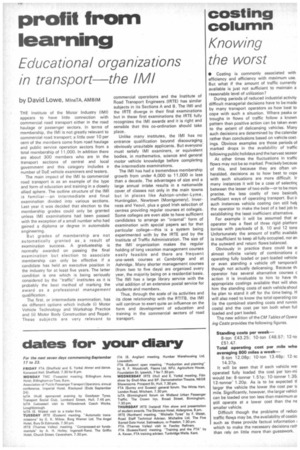Costing
Page 80

Page 81

If you've noticed an error in this article please click here to report it so we can fix it.
column Knowing the worst
• Costing is commonly associated with efficiency and efficiency with maximum use. But what if the amount of traffic currently available is just not sufficient to maintain a reasonable level of utilization?
During periods of reduced industrial activity difficult managerial decisions have to be made by many transport operators as how best to cope with such a situation. Where peaks or troughs in flows of traffic follow a known pattern then positive action can be taken even to the extent of delicensing vehicles. Many such decisions are determined by the calendar rather than conclusions based on vehicle castings. Obvious examples are those periods of marked drops in the availability of traffic following public holidays and the harvest seasor
At other times the fluctuations in traffic flows may not be so marked. Precisely because of this, and because they are often unheralded, decisions as to how best to cope with such situations are more difficult. It many instances it will be a case of selectinc between the lesser of two evils—or to be more precise, the less costly of two basicall} inefficient ways of operating transport. But ir such instances vehicle costing can still heir the operator to make the best of a had job ht establishing the least inefficient alternative.
For example it will be assumed that am operator has a fleet of three rigid. platforrt lorries with payloads of 8. 10 and 12 tons Unfortunately the amount of traffic availabli is insufficient to keep all fully occupied, nor an the outward and return flows balanced.
Obviously in practice there could be at almost infinite variety of combinations o operating fully loaded or part loaded vehicle or even standing a vehicle off temporarit though not actually delicensing. Because th operator has several alternative courses c action it is invaluable to him to have th appropriate costings available that will sho■, him the standing costs of each vehicle shoul he plan to stand it off for the time being. will also need to know the total operating co: lie the combined standing costs and runnin costs) and the cost per ton both when full loaded and part loaded.
The new edition of the CM Tables of Opera ing Costs provides the following figures. Hunter (London) Ltd has veloped a heavy-duty lift table th a swing lip, that is known the Truck Loader and is signed for loading vehicles im ground level. It is said to be rticularly suitable for operators io have to load containers by t truck through the rear ening of a van from a loading nk that is not equipped with a ck leveller.
In operation, a fork-lift or Ilet truck is driven on to the lift rle when it is flush with the or. A press-button control is erated by the driver from his 3ted position or at floor level raise the platform to vehicle ck height and to lower the ing lip to rest on the bed. The ck is then driven into the licle to drop or pick up a load. The Truck Loader is of welded steel construction_ It supplied as a self-contained t, the hydraulic power pack ng located within the frame. ctric power is derived from
mains; in the event of a ever failure the table is held tionary.
Safety features also include a mterbalanced-bar wheel stop t automatically retracts when platform is at floor level and ends when the platform is sed to safeguard against irride of the vehicle. An omatic-stop trip bar is fitted he underside of the platform. de by: G. Hunter (London) , Gumley Road, Grays, Essex.




















































































































